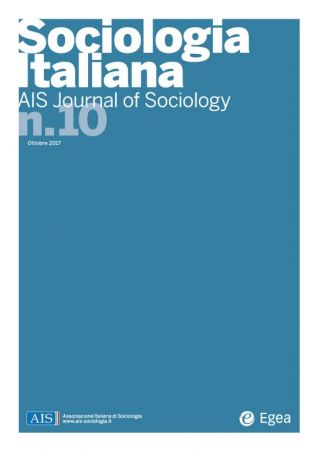AIS
2017/10
Autoetnografia e interazionismo simbolico: un modo di essere e di vedere il mondo (Autoethnography and symbolic interactionism: a way of being and seeing the world), di Charlie Barnao
Oggetto di questo lavoro è lo studio del legame tra la strumentazione concettuale dell’interazionismo simbolico e l’etnografia, con un particolare riferimento all’autoetnografia. Etnografia e interazionismo simbolico si intrecciano tra di loro in modo profondo e inscindibile sia da un punto di vista storico sia per quanto riguarda le basi teoriche di riferimento. Il luogo e il tempo che manifestano questo profondo legame sono quelli della Scuola di Chicago, agli inizi del secolo scorso, alle origini della sociologia urbana e della sociologia applicata. Dopo avere brevemente introdotto alcuni cenni storici relativi al collegamento tra interazionismo simbolico ed etnografia e dopo avere dato una definizione essenziale di autoetnografia, analizzo il legame tra interazionismo ed etnografia attraverso il metodo della meta-autoetnografia. Le principali proposizioni generali che emergono dal mio lavoro sono: a) la vita sociale, le identità, le relazioni sociali sono fluide, non statiche e la ricerca autoetnografica è una etnografia consapevolmente situata; b) la ricerca autoetnografica è aperta, ma radicata nelle trasformazioni dell’«ostinata realtà» (Blumer) con le quali il ricercatore negozia il processo di interpretazione e di comprensione etnografica; c) le «epifanie» (Denzin) e i «concetti sensibilizzanti» (Blumer) sono strumenti cruciali per l’interpretazione autoetnografica; d) l’autoetnografia è un modo di vedere il mondo. Il processo autoetnografico è un processo lungo, aperto, flessibile, spesso molto faticoso, di comprensione della realtà. L’autoetnografo è egli stesso osservato e osservatore. Il suo modo di osservare il mondo che lo circonda diventa anche il modo attraverso il quale filtra tutte le informazioni che gli permettono di comprendere la realtà che sta studiando in un continuo e incessante processo interpretativo.
Autoethnography and symbolic interactionism: a way of being and seeing the world
The subject of this paper is the link between the conceptual tools of symbolic interactionism and ethnography, with particular reference to autoethnography. Ethnography and symbolic interactionism are closely intertwined, both from a historical point of view and in terms of their theoretical points of reference. This deep bond formed in the context of the Chicago School at the beginning of the last century, in the early days of urban sociology and applied sociology. After briefly introducing some historical references to the link between symbolic interactionism and ethnography, and offering a basic definition of autoethnography, we analyze the link between interactionism and ethnography using the metaautoethnographic method. The main general propositions that emerge from our work are: a) Social life, identities, social relationships are fluid, not static, and autoethnographic research is a consciously situated form of ethnography; b) Autoethnographic research is open but grounded in the transformations of «obdurate reality» (Blumer), with which the researcher negotiates the process of ethnographic interpretation and understanding; c) «Epiphanies» (Denzin) and «sensitizing concepts» (Blumer) are crucial tools for autoethnographic interpretation; d) Autoethnography is a way of seeing the world. The autoethnographic process is a time-consuming, open, flexible, and often very demanding way of understanding reality. The autoethnographer is himself both observed and observer. His way of viewing the world around him also becomes the prism through which he filters all the information that allows him to understand the situation he is studying, in a continuous, ongoing process of interpretation.
Keywords: Etnografia, Interazionismo simbolico, Autoetnografia, Meta-autoetnografia, Etnografia pubblica, Ethnography, Symbolic interactionism, Autoethnography, Metaautoethnography, Public ethnography
DOI: 10.1485/AIS_2017/10_OTTOBRE_3429665
Pagine 221-233
L'ACCESSO A QUESTO CONTENUTO E' RISERVATO AGLI UTENTI ABBONATI
Sei abbonato? Esegui l'accesso oppure abbonati.
